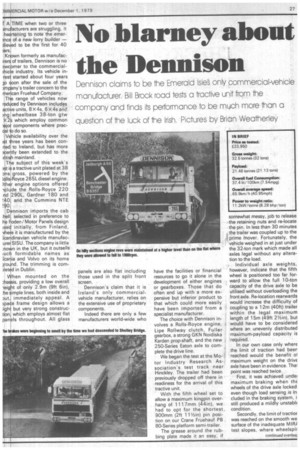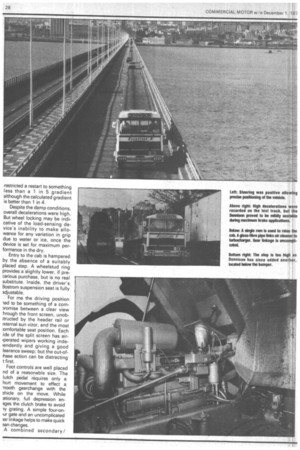No blarney about the Dennison
Page 29

Page 30

Page 31

If you've noticed an error in this article please click here to report it so we can fix it.
Dennison claims to be the Emerald IsleS only commercial-vehicle manufacturer. Bill Brock road tests a tractive unit from ne company anc finds its performance to oe much more nan a.
question of e luck of e Irish, Pictures by Brian Weatherley
r A TIME when two or three anu acturers are struggling, it .heartening to note the emermce of a new lorry builder — .11ieved to be the first for 40 iars • Kn wn formerly as manufacIre of trailers, Dennison is no 3WC mer to the commercial!hie e industry. Its vehicle inres started about four years jo oon after the sale of the )rri ny's trailer concern to the me can Fruehauf Company.
T e range of vehicles now rod ced by Dennison includes acti e units, 8 X 4s, 6X 4s and )ng wheelbase 38-ton gtw X2 which employ common lajo components where praccal o do so.
V hide availability over the 1St three years has been conned to Ireland, but has more certly been extended to the .ritish mainland.
e subject of this week's st i a tractive unit plated at 38 Dns gross, powered by the lolls Royce 265L diesel engine. lth r engine options offered ricl de the Rolls-Royce 220 nd 290L, Gardner 180 and !40 and the Cummins NTE !90
• D nnison imports the cab hell selected in preference to he oden/ Motor Panels design rse initially, from Finland, vhe e it is manufactured by the 3ca dinavian vehicle manufacure SISU. The company is little no n in the UK, but it outsells ;uc formidable names as 3cartia and Volvo on its home iroUnd. The trimming is corn)leted in Dublin.
When mounted on the ;hassis, providing a low overall leight of only 2.9m (9ft 6in), :he Simple lines, both inside and )ut, immediately appeal. A 3pa e frame design allows a igh but very strong construction which employs almost flat pan Is throughout. All glass
panels are also flat including those used in the split front screen.
Dennison's claim that it is Ireland's only commercialvehicle manufacturer, relies on the extensive use of proprietary components.
Indeed there are only a few manufacturers world-wide who have the facilities or financial resources to go it alone in the development of either engines or gearboxes. Those that do often end up with a more expensive but inferior product to that which could more easily have been imported from a specialist manufacturer.
The choice with Dennison involves a Rolls-Royce engine, Lipe Rollway clutch, Fuller gearbox, a strong GKN Noidiska Karden prop-shaft, and the new 250-Series Eaton axle to complete the drive line.
We began the test at the Motor Industry Research Association's test track near Hinckley. The trailer had been previously dropped off there in • readiness for the arrival of this tractive unit.
With the fifth wheel set to allow a maximum kingpin overhang of 1117mm (44in), we had to opt for the shortest 900mm {2ft 11 1/2in) pin position on our Crane Fruehauf PB 80-Series platform semi-trailer.
The grease around the rubbing plate made it an easy, if somewhat messy, job to release the retaining nuts and re-locate the pin. In less than 30 minutes the trailer was coupled up to the prime 'mover. Fortunately, the vehicle weighed in at just under the 32-ton mark which made all axles legal without any alteration to the load.
, Individual axle weights, however, indicate that the fifth wheel is positioned too far forward to allow the full 1 0-ton capacity of the drive axle to be utilised without overloading the front axle. Re-location rearwards would increase the difficulty of coupling to a 12m (40ft) trailer within the legal maximum length of 15m (49ft 21/2in), but would have to be considered where an unevenly distributed maximum-payload capacity is required.
In our own case only where the limit of traction had beer reached would the benefit oi maximum weight on the drive axle have been in evidence. Thai point was reached twice.
First, it was achieved undei maximum braking when thE wheels of the drive axle locked even though load sensing is in eluded in the braking system, i still produced a mildly unstabl( condition.
Secondly, the limit of tractior was reached on the smooth we surface of the inadequate MIR/ test slopes, where wheelspir restricted a restart to something less than a 1 in 5 gradient although the calculated gradient is better than 1 in 4.
Despite the damp conditions, overall decelerations were high. But wheel locking may be indicative of the load-sensing device's inability to make allowance for any variation in grip due to water or ice, once the device is set for maximum performance in the dry.
Entry to the cab is hampered by the absence of a suitably placed step. A wheelstud ring provides a slightly lower, if pre;.:arious purchase, but is no real substitute. Inside, the driver's, Bostrom suspension seat is fully 3djustable.
For me the driving position lad to be something of a corn3romise between a clear view hrough the front screen, unobitructed by the header rail or ixternal sun vizor, and the most :ornfortable seat position. Each ide of the split screen has air'permed wipers working indeiendently and giving a good learance sweep; but the out-ofihase action can be distracting t first.
Foot controls are well placed nd of a reasonable size. The lutch pedal requires only a hort movement to effect a Tiooth gearchange with the ahicle on the move. While ationary, full depression en ages the clutch brake to avoid grating, A simple four-onur gate and an uncomplicated 3ar linkage helps to make quick an changes.
A combined secondary/ park-brake lever, located on the top of the low-profiled engine cowl, forward of the gear stick, iS also within easy reach.
Instrumentation on a compact binnacle gave all the inforMation needed at a glance.
Early starts in the half light of t e first and second days of the t st dispelled any fear that the b might become very cold due tp the extensive use of glass. he heater was well up to the job nd quickly brought the internal t mperature to a comfortable vel.
When the cab is used for leeping some of the glass anes can, alternatively, be pecified with blanking panels. tested, the cab is certainly light, with an air of spacious the legal maximum for long periods. The ability of the RollsRoyce 265L power unit in pulling, without labouring, down to around 1000rpm, minimised the need for gearchanges and aided the fuel performance without apparent detriment to journey times.
At 40mph the unit pulled at around maximum torque, 1200rpm in top gear, while on the steeper inclines, as encountered along the A68, engine revs were maintained at a higher level with down changes made at 1500rpm. But even so sometimes a gear needed to be missed out in down changes.
The Dennison is not the quietest vehicle I have driven, but it was acceptable. At 60mph, noise levels were lower than at 40mph; but 50mph seemed to be about the best speed with regard to noise.
The notorious Riding Mill is no more, since the road has been re-routed to avoid it. This change, together with the diversion in Consett, slightly increased the overall mileage.
But having lost one hill we have gained another. Blackhill, although not as steep as Riding Mill, is formidable and has to be completed from a virtual standing start because of a hairpin bend at Shotley Bridge.
Although only 2.3km (1.43 miles) in length it is a long grind, taking 7 min 28 secs to climb •— an average of 19.4km / h ,(11.49mph). The long descent prior to the hairpin bend along the B6278 has to be taken steadily, and can provide a good opportunity to really test.the brakes.
Absence of an exhaust brake added to the number of servicebrake applications. The brakes were smelling strongly by the time we reached the bottom, but still had stopping power in hand.
Despite only 26,000 demonstrator kilometres on the clock, on my first full brake application at MIRA an air-pipe parted from the foot valve. Closer inspection showed that the olive used on the nylon pipe had been incorrectly fitted at the outset. The problem did not recur when a new olive was fitted.
Steering is precise, giving good feel and directional control. The ride was firm and chassis and cab roll were hardly perceptible unless the vehicle was cornered very hard.
Conservative fuel consumption over each section showed the best result achieved in a CM road test with a Rolls-Royce 265L powered vehicle. It returned 37.4 lit/100km (7.54mpg) — despite the sun
visor at an overall average speed of 65.9km /h (40.95 mph).
The chassis is substantial and probably heavier than it need be, but nevertheless the unladen weight given for the tractive unit alone is lighter than many plated for the same weight.
Engine access is made possible by a single hydraulic ram which tilts the cab to 57. Since our test vehicle was produced, a minor design change allows the rear wing section to remain static during this operation. While this has reduced the discomfort of muck or water dripping onto the mechanic, it possibly restricts the area behind the wheel.
Everyday inspections are easily made. Coolant is behir the front nameplate flap, ar the oil dipstick can be reachE ,through an inspection ho above the step.
Summary
Dennison's choice of pr prietary components and tl manner in which they have be' assembled add up to a vehicle which the company is justifiat proud.
To an extent, though, ti vehicle is still evolving. As small company with an outp of about three vehicles a wee minor criticisms can be rectifi more easily, than for a larc company producing hundrec ,Already a step has been inti duced below the bumpei Wipers will be changed to eli tric but, because of restrict room behind the front pan must remain independen• operated. The interior sun visi are also to be changed to t more conventional flap type.
Fuel consumption and jo .ney times both rate highly in c tables. The brakes produc good stopping distances, t brake ratios, front to rear, ne some modifications from I point of stability..
Indirectly, a shorter whE base and a repositioned fi wheel would improve tract and allow the legal capacity the drive axle to be used with overloading the front axle wi staying within 15m overall.
The general appearance the vehicle is good; and Der son has just made an agreem with R. Cripps of Nottinghz who has 10 depots, to prov service facilities.
For the operator who neec vehicle plated for 38 tons wants to stay with well-tes components, the Dennison I vides it all at a cost of £.23,.C. which includes spare wheel ; fifth wheel.
















































































































